I have heard the big TADs before with Pass XA 160.5, with Boulder 2160 (Boulder 2110pre, Basis TT and Lyra Atlas with Boulder 2008 phono) during my trip to Italy.
The above are the Italian pics.
So I sat down in this 8m x 5m room to listen to them with the VTL 7.5 mkIII and VTL Siegfrieds. Next to the VTLs you see the MSB 204.
These notes will highlight differences heard that day between
- VTL Siegfried and MSB 204 through both digital and analog on the TAD reference
- Ayon SACD (CD 35 signature) player and Meridian 808.6 CD player
- Schroeder CB (Captive Bearing) Carbon Fibre arm + My Sonic Labs , and the Kuzma 4p 11’ + Clearaudio GFS on the $40k Dohmann Helix 1 (made by Mark Dohmann, designer of the Continuum Caliburn and Copperhead tonearm) played through a Thrax Orpheus phono. This was done using both the VTL and the MSB amps. This was the key objective of my trip
We started off listening to the Meridian CD player. Playing an aria, some soft and loud orchestral from Pictures at an exhibition, I got a feel of the system.
Then we moved to the Dohmann. The carts had been warming up as we played the CDs. We started with the Bruch Scottish Fantasia and the Faust Gounod Ballet. I thought both the carts were equally neutral, the Schroeder MSL was more relaxed while the Kuzma GFS had some more energy, and a slight more bass and authority. The gain of the GFS seemed higher and we had to reduce the volume slightly. On Bruch, the Kuzma was more natural while the Schroeder MSL seemed more damped. My host tried adjusting the VTA but that did not change. On the Faust, the Kuzma had a bit more snap, and slightly forward, but not much of a difference.
On Scheherazade 4th movement, both combinations seemed equal. There was not much to choose from. So we changed to the first movement, where again there was not much difference to note.
So I put in the Rubinstein Emperor. The Kuzma GFS now played the piano with more attack and intervals and when the orchestra would join in, would be more explosive. I was not enjoying it with the Schroeder MSL on this one, and my host shared the view.
I have heard the Dohmann in 2017 and 2016 at Munich with the Schroeder and the Lyra, and also the smaller version (26k Euro Helix 2) with the Etna at Munich 2017, through the Thrax. I must say Munich gives a good flavor of this TT, the TT is extremely clean and linear, and stable, colorless. Piano is steady like a DD. It shakes as it has an integrated Minus K for support, and is usually teamed with the Schroeder CB and Thrax, so these components are voiced together. Audio Union who produces this set is comprised of Mark Dohmann, Schroeder, and the Thrax manufacturer, among others.
So I put on Argenta Espana, a Decca SXL, this recording shows nice detail and depth and stage. On this, the difference between the Schroeder MSL and the Kuzma GFS was huuuge. The Schroeder MSL had way better tone on brass, oboe, and other wind instruments, had more depth and detail, and as the string section plucked at the strings, the orchestra had a great gallop. It was much more dynamic, great bass, felt faster during the slams, and retained detail and control in the crescendos. Both of us were surprised. Had the MSL now warmed up?
https://www.discogs.com/Argenta-The-London-Symphony-Orchestra-Espa%C3%B1a/release/2980560
So we put back the Rubinstein again. No Luck. The differences were as noted before. So I put on the Schubert Winterreise. The Schroeder MSL had much more connection, more emotion, the low to high dynamic range seemed greater, and the piano stood out more distinctly. The Kuzma GFS seemed slightly cleaner and more analytical, but the preference was clearly Schroeder MSL.
I insisted we do this comparison again on the MSB, to see if then we could have a clear winner. The MSB amps had been on all this while, and after playing some digital, we again moved to the analog.
Interestingly, the Kuzma GFS now was as involving and mesmerizing as the Schroeder MSL on the Winterreise. The MSB amps held their own against the VTLs on this.
The Rubinstein Emperor, where both of us had preferred the Kuzma GFS before, now we preferred the Schroeder MSL. The piano tone was better, and unlike before, the Schroeder MSL was more explosive. Compared to the VTL, the MSB had less dimensionality on the piano and less involvement.
On the Argenta Espana, the Schroeder MSL retained its high margin lead. Both of us thought the MSB did extremely well here, and we slightly preferred the VTL due to the bloom on instruments.
On the Bruch Scottish Fantasia, the Kuzma GFS, like before, sounded more natural. It had a higher, sharper timbre to the violin as compared to the MSL. MSB and VTL were both equally good on this.
On Scheherazade, like before, there was not much difference. If anything, the violin sounded more tonally natural on the Schroeder MSL unlike on the Bruch – the Scheherazade violin though is sweeter.
Both my host and I shared a similar conclusion on each LP, as well as the fact that it was not possible to judge in favor of one. He did say his preferences change from LP to LP on a regular basis.
Sometime later he will swap the carts on the arms, and then it might become more clear. Or might not. The interesting thing was how the differences were different depending on the amp used, clearly showing how complex analog is. There was a big gain play happening in the chain. The MSB is a low gain amp and we had to change the VTL pre to a higher gain, and also keep MSB on the higher gain. It just did not sound right with the lower gain.
Pragmatically, I would say that of these two combos, one should just go with the best deal one gets. And definitely do not change to the other if you have one of these. At this level there isn’t really much to choose from. Neither carts have a strong color like the Koetsu that will make you lean towards or away from one or the other.
If I had a gun pointed to my head and had to choose, I would pick the Schroeder. The difference on Argenta Espana was huge and consistent on both amps, and the depth, control, and speed could be more a function of the arm. So much more space on the Argenta Espana, and the musicality. It looks beautiful too. But is much more complicated to set up. An ideal scenario would have been that where the Schroeder MSL fell short (violin on the Bruch and the piano on the Rubinstein Emperor on the VTL (not on the MSB)), one could change the VTA and SRA to match. But then what if one changed the Nordost wire in the Kuzma?
One would need more quality records with complex crescendoes and different piano pieces to stress these two
Interesting to read an old Schroeder vs Durand Talea thread on the gon
The difference between the MSB and VTL was narrow on analog. However, interestingly, the preference with the Ayon SACD and the Meridian was more skewed towards the VTL. On digital, the VTL had more differences in body, holography, and largeness, especially on vocals and choir. The MSB was darker, more rolled off, and seemed smaller. It had a much lower noise floor that allowed you to see into the music, while the VTL had more drive and larger stage and images. The VTL was more forward while the MSB was more back of stage. Among SS amps, The MSB possibly suits well the Beryllium drivers of the TADs.
The TADs are the right size, not too big to show glaring driver mismatch, and have a nice bottom end. Their mid bass is full, vocals and involving, and they soundstage and slam well. They need good control and drive. There is a big change in soundstage, flow, and brightness as you change gear. Compared to the Pass and the Boulder systems I heard, this was a much better set up with both the amps, while VTL and MSB could be a SS/valve preference. But the MSB was so much better with the TADs than when I heard them with the Tannoys
I have heard the smaller floorstanders with Luxman m900u and Viola Symphony, and the TAD CR1 with Luxman m900u and Gryphon Mephisto. It would be interesting to hear the big ones with Gryphon or Symphonic Line Kraft
The Ayon SACD which started off as bright when first put in, sounded really nice and better than the Meridian once it warmed up. The Ayon had more flow on Old Castle (Pictures) and the detail and bass on Gnomus was the same, but the tone was better with the Ayon. The orchestra expanded and soundstaged more naturally with the Ayon. The Ayon was brighter than the Meridian but in a good way, not harsh.
The room is is a bit live, in a nice way, can be a bit damped without getting overdamped. It would be interesting to see what a change in phono does, especially one giving a large deep soundstage like the Aesthetix, or an SS phono. The host also loves the Ayon.
We did the session over a 5 hour period, with one small coffee break in between.
All in all, a great learning session for me on how to be satisfied with the analog deal that one can get. I would have liked to rule out one but that is not possible. Will have at least one more Schroeder compare, and a few GFS compares. One is already here.

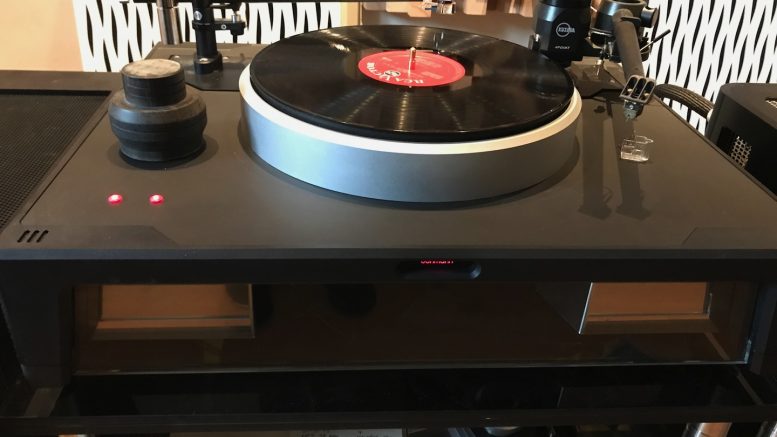
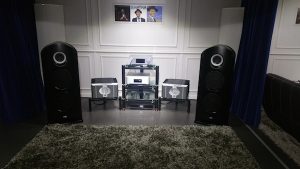
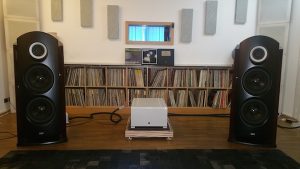
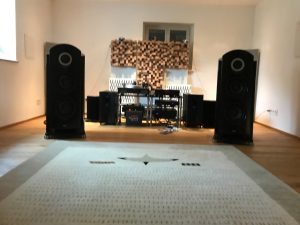
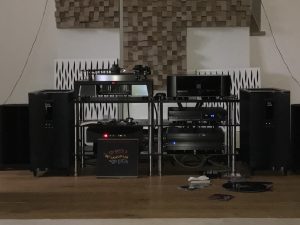
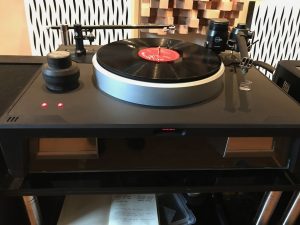
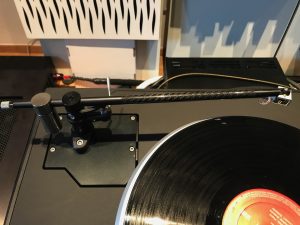
Be the first to comment on "Dohmann Helix 1, Schroeder CB + My Sonic Labs, Kuzma 4p + Goldfinger Statement"